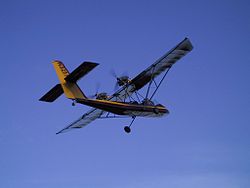Leza-Lockwood Aircam
| Leza-Lockwood Aircam | |
|---|---|

|
|
| Type: | Microlight |
| Design country: | |
| Manufacturer: |
Lockwood Aircraft Corp. |
| First flight: |
1993 |
| Commissioning: |
1993 |
| Number of pieces: |
> 160 |
The Leza-Lockwood Aircam is a two-seat twin-engine ultralight aircraft produced by the US manufacturer Lockwood Aircraft Corp. based in Sebring (Florida) .
development
The Aircam was built on behalf of National Geographic by the ultralight pioneer Phil Lockwood as a camera aircraft (Air Cam) for extensive filming of the Ndoki rainforest in the Republic of Congo . In order to prevent possible engine failures and the associated emergency landings, it should be designed with two engines. This required a large vertical stabilizer and a very stable fuselage to absorb the torsional forces .
Convinced of the idea of the construction, he founded the Leza-Lockwood Company with financier Antonio Leza to sell the Aircam as a kit for everyone with a price of around 100,000 US dollars . The model with serial number 001 is on display at the EAA AirVenture Museum in Oshkosh, Wisconsin .
Technical specifications
| Parameter | Data |
|---|---|
| crew | 1 |
| Passengers | 1 |
| length | 8.23 m |
| span | 10.97 m |
| height | 2.54 m |
| Empty mass | 472 kg |
| Max. Takeoff mass | 762 kg |
| Cruising speed | 122 km / h |
| Top speed | 177 km / h |
| Range | 544 km |
| Engines | two four-cylinder, four-stroke Rotax 912 boxer engines |
Web links
Individual evidence
- ↑ airventuremuseum.org: information on the website of the EAA Airventure Museum
- ↑ AirCam Specifications; Manufactured and Distributed by Lockwood Aircraft . ( aircam.com ).